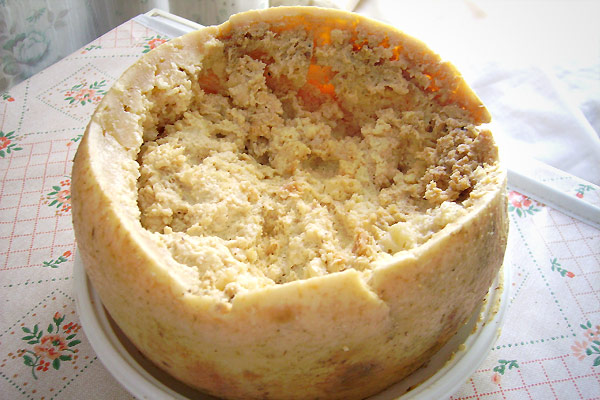âCasu Marzuâ has its origins found in Sardinia, one of the largest islands of the Mediterranean Sea, in Italy. It is a rich cheese (made from milk of Sardiniaâs special breed of sheep), containing with live larvae. It is most sought after cuisine in Sardinia. However, it does sound pretty ironical that the lawmakers once proclaimed it as illegal, that too in the place where it found its taste. As a banned specialty (the ban has been lifted recently) in Sardinia, âCasu Marzuâ came as a divine blessing to black marketers, who sold it at double rates. The preparation âCasu Marzuâ ought to be credited to its maker, Pecorino Sardo.

The wacky tinge:
Although Casu Marzu boasts to be a Sardinian specialty, it could win hands down to be on the top contender list of foods on Fear Factor or any other adventurous, adrenaline oozing Reality TV shows of the world. Thus, very rightly goes the Sardinian dialect, when they name its specialty cuisine as ‘rotten food’. As if it was not enough for Casu Marzu to be a natural breeding ground for maggots, this cheese breeds company! Many blocks of Italian pecorino cheeses now follow the trend set by Casu Marzu, in becoming breeding grounds for a whole cluster of natural harbingers of rot and filth.
Ingredients of this Italian maggot buster:
Essentially a cheese, made from milk of finest breed of sheep, with thoughtful inclusion of Piophila casei, (cheese fly) by its maker Pecorino Sardo. This decomposed state of maggot ridden specialty requires a serious eye protection. The transparent larvae, creatively placed inside set loose as they bounce approx. 6 inches into the air, as the delicacy gets tasted. The taste is extremely pungent and could burn the tongue in no time. As you gobble up this delicacy, it is time you get ready for a roller coaster experience to literally feel your stomach as it welcomes the larvae in their undigested state. Even you can sense a drill passing through the intestine, as the larvae attempt to go through it.
The process:
The main process of making Casu Marzu lies in the act of removing part of the cheese rind, without disturbing the other whole of Pecorino cheese. This is done in order to enable Piophila casei to lay its eggs inside it. Once the rind is removed, the cheese is made to lie in dark hut filled Piophila casei, for four to five months, by which time the eggs would be hatched into larvae. This is a magical moment indeed. Now, the Pecorino cheese transforms into a Casu Marzu. The larvae eat the rotten cheese as the acid in their system tends to give Casu Marzu its unique legendary flavor and texture.
It is a researched suggestion that female Piophila casei has ability to lay over five hundred eggs at once. After the eggs hatch, crawling larvae start feeding themselves through it. Maggots’ tend to breaks down the cheese’s fats, through acid contained in their digestive system. Casu Marzu will contain thousands of these maggots at the time of getting ready for human consumption.
Health risks
There are lots of Casu Marzu fanatics who throng to have this delicacy. While most like their Casu Marzu to be without maggots, there are some others who are belong to the live wire lot. These lots of people like to gobble Casu Marzu with live maggots in it. However, utmost care ought to be taken by these to cover their eyes with protection, to avoid their eyes pierced by maggots while taking a bite. As stated earlier, maggots have the ability to jump up to 6 inches into air. The question lies whether eating âCasu Marzuâ with maggots is perfectly fine for oneâs health.
Research studies affirm the fact that if Larvae is eaten alive, either by choice or accidentally, have the tendency to live alive in our intestines for quite some time as human stomach acids do not kill larvae. Cheese fly larvae, used/produced in Casu Marzu have the potential to cause myiases, a serious threat to all humans. Moreover, as the live larvae try to drill through intestinal walls, an individual having eaten the delicacy can well experience symptoms of acute pain in the abdomen, nausea, blood stained diarrhea and vomiting, among other things. For such reasons, the authenticity of eating this Sardinian delicacy is questioned to a great extent.
However, Casu Marzu still will continue to be lapped up by its zillion fans (must be Sardinian or the likes), irrespective of any studies which proclaim it as a threat to health.


